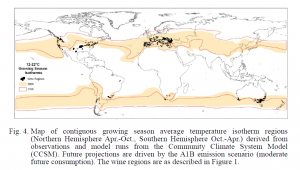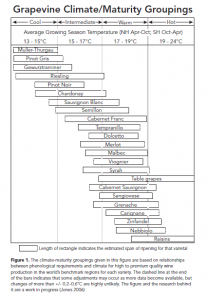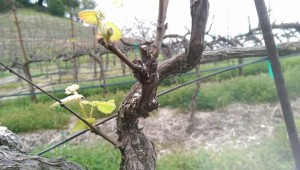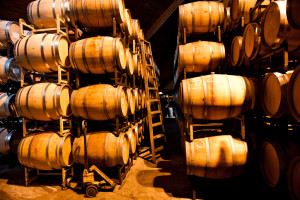 The following article is my first contribution to the print magazine SOMM Journal. I feel very honored to have been given the opportunity to write for this fantastic periodical and encourage each and every one of you to check it out when you get a chance. With 6 issues per year, subscriptions are FREE to those in the wine industry. There is a fee for non-industry folks. Please visit the SOMM Journal site to download the latest issue of the journal, as well as read web-only exclusives. You may also subscribe to SOMM Journal on their website or go there directly by clicking here.
The following article is my first contribution to the print magazine SOMM Journal. I feel very honored to have been given the opportunity to write for this fantastic periodical and encourage each and every one of you to check it out when you get a chance. With 6 issues per year, subscriptions are FREE to those in the wine industry. There is a fee for non-industry folks. Please visit the SOMM Journal site to download the latest issue of the journal, as well as read web-only exclusives. You may also subscribe to SOMM Journal on their website or go there directly by clicking here.
Reprinted with permission.
NOTE: This post also received 3rd Place in the 2015 Born Digital Wine Awards.
Without further ado, here is the digital debut of my piece for SOMM Journal:
Climate change—be it brought on by anthropomorphic sources, the natural cycle of the earth, or a combination thereof—is and will continue to have a significant influence on global ecosystems, including agricultural and viticultural systems. Since the beginning of the 20th century, we’ve already seen increases in atmospheric CO2 levels and a global temperature increase of 1.4oF, and models predict even further increases even in the best-case scenarios.
Climate change won’t affect every region the same way. Specifically, models predict greater warming over land and higher northern latitudes. While daytime temperatures on average will increase, it’s the increase in nighttime low temperatures that is of particular note.
For grapes specifically, current models predict that growing and ripening seasons are likely to change in some places, while some find that temperatures will increase so much that varieties of grapes traditionally grown in certain region will no longer survive there.
Viticultural regions are defined by a relatively narrow geographical strip in the middle latitudes between 12oC and 22oC average daytime temperatures. Wine grapes are very fussy and can only be grown in certain niches or microclimates in order to produce the quality wine accepted today.
Vitis vinifera grapes are known to grown anywhere from 13oC–15oC, as we see in cool -climate grapes such as Müller-Thurgau or Pinot Gris, to 17oC–24oC, as we see in hot-climate grapes such as Zinfandel and Nebbiolo. Most wine grapes are grown between 12oC and 22oC, while other varieties are more sensitive and can only grow within a much smaller temperature range in order to produce quality wines. Due to the sensitivity of a lot of vinifera grapes, increases in local temperatures could spell disaster.
Take Pinot Noir for example: Unlike some more temperature-hardy grapes, Pinot Noir can only grow in a very narrow 2oC range, between 14oC and 16oC, as we see in Burgundy or in northern Oregon. Of course, the plant itself can grow in a wider temperature range; however, in terms of wine quality, any deviation from this 14oC to 16oC range will result in lower quality wines and thus a negative influence on the local wine industry. If global temperatures rise higher than the predicted 2oC increase in the best case scenario, we’ll likely see that regions like Burgundy and Oregon may no longer be able to produce quality Pinot Noir wines due to the fact that temperatures in that region are no longer in the ideal range.
On the other hand, climate change does not spell doom and gloom for every wine region. In fact, newer wine regions in locations that were historically too cold will likely see temperatures increase to a point where they are now in the “longitudinal sweet spot” for grape growing.
Rising global temperatures will ultimately lead to an upward shift of the ideal grape-growing zone throughout the world, markedly changing local wine industries either for the worse in the case of those already teetering on being too hot for grapes, or for the better for those that were historically too cold but now are within that 10oC range for quality wine grape growth. Models also predict that brand new areas could be suitable for wine grape growing that had not been considered in the past.
If no attempts to mitigate climate change are made, by 2100 the US will likely see an 81% reduction in suitable wine grape acreage (White et al, 2006), with upwards of half of the current acreage in Napa and Santa Barbara counties lost by 2040 (Diffenbaugh et al, 2011).
Sea Levels and Precipitation
Not only are rising temperatures themselves a direct problem, but they also result in the melting of the polar icecaps and high-altitude snow packs, thus raising sea levels and changing ocean currents. Since ocean currents are a major driver of weather throughout the globe, any change in this current may change weather patterns and spell disaster for industries relying on the weather for maximizing product quality—like grapes and wine.
Current models predict that global sea levels may rise anywhere from 0.2m to 4m. At 5m, models show lower-lying grape growing regions such as Bordeaux, Portugal, New Zealand, parts of Australia and parts of California will see increases in flooding by sea water, resulting in increased salinity in the soil and hampered vine growth.
Regarding precipitation, current models project decreases in sub-tropical regions, while at the same time increases in higher northern latitudes and near the equator. Drought pressure will continue to be seen in certain regions, as we’ve seen already in Australia and in much of California and the Pacific Northwest. Increased precipitation events could lead to increased erosion in the vineyards, as well as decreased nutrient availability in the vineyard soil, ultimately hampering vine growth.
Physiological Changes
The impact of climate change on viticulture and winemaking is not simple. In fact, while temperature increases are the primary culprit, there are many other factors that are affected by climate change.
As daytime temperatures continue to increase, research has shown that different physiological changes in the grape vine occur and will continue to occur. Events like bud break, bloom, veraison and harvest dates are happening earlier and are predicted to occur even sooner as global daytime temperatures increase. Additionally, not only are these important developmental events in the grapevine going to occur earlier and earlier, but the number of days in between these events will also shorten. Specifically, with every 1oC increase, it’s predicted that there will be an accompanying 5 to 10 day earlier date for these physiological events.
Studies have shown that earlier events like veraison could have tremendous impacts on wine quality. If veraison, the start of the ripening phase for grapes, starts earlier in the season, then the ripening process will also occur earlier in the season when the temperatures are at their hottest in many places.
Earlier veraison and ripening spells major changes in the chemistry of the grape, including increased sugar levels, decreased acid levels and decreased anthocyanin, pyrazine and methoxypyrazine levels. Increased sugar levels, in turn, lead to increased alcohol levels as well as changes in wine flavor and mouthfeel. Decreased anthocyanin levels lead to less stable color characteristics and quality in red wines, while decreased pyrazine levels lead to fewer wines having the undesirable sensory characteristic of “green” or “vegetal.” Overall, earlier veraison and ripening as a result of climate change will markedly change the chemical composition of grapes, ultimately leading to marked changes in the sensory characteristics and quality of the finished wine.
Pests & Disease Pressure
In addition to changes in the physiological development and growth of the grape vine, increased pressure from pests and other diseases will also become more prominent as time goes on. Like grapevines, insects and pests also have ideal temperature ranges within which they can growth, survive and propagate. As global temperatures increase, we should also see a shift in the range where different pests and insects can grow and thrive.
For example, the glassy-winged sharpshooter is an invasive pest to California and harbors Pierce’s disease, a disease known to cause significant economic losses to those vineyards where it has attacked. Some models predict the distribution and severity of the glassy-winged sharpshooter to increase, potentially invading significantly more vineyards and agricultural fields in California, Oregon, and Washington as temperatures increase further.
Oak Wood Quality
One often overlooked effect of climate change on the global wine industry relates to the quality of the wood used for barrel aging, a technique often used in higher quality wines. Increased CO2 levels in the atmosphere as a result of global climate change has been shown to increase the growth rate of various trees, including those oak trees used in quality wine-barrel production.
This increased growth rate in oak trees results in the size and number of the vessels utilized by the tree to transport water and other nutrients throughout the plant, thus potentially leaving the wood more susceptible to breakage and damage during and after barrel production.
Additionally, increased CO2 levels results in decreased ellagitannins in the oak wood, thus reducing the levels of oak tannins imparted into wine aged in barrels made from this wood, ultimately changing the sensory characteristics of the finished wine and potentially reducing quality.
Future Directions
Depending upon the location, climate change will likely affect grape growing and winemaking somewhat differently. While understanding physiological changes of grapes in a changing climate is relatively easy, figuring out how to adjust to these changes may be more complicated.
In addition to the chemistry and science behind it, wine has a human element, which may or may not be amenable to necessary adjustments required due to climate change. The flexibility and adaptability of the “human factor” will be key in the successes or failures of a given region. Putting aside old traditions and identities will be critical in a given wine region’s ability to stay alive in this rapidly changing global climate.
Understanding the effect of climate change at the local level will be significant for those wine regions looking to stay afloat. How is the temperature predicted to change in the region? What sort of grapes can grow in the predicted future climate for that region?
In addition to simply planting knew known varieties, research and development of new varieties that can potentially withstand higher temperatures, wild weather events, pest invasion or any other direct or indirect effect of climate change will be critical for those regions teetering on the edge of “sweet spot” zone for grape growing.
Marketing of a highly diverse portfolio of grape and wine styles will be of utmost importance in helping to increase consumer demand for these new wines, thus alleviating some of the pressure of having to maintain certain traditions or personas and allowing a wine region to thrive under any climate change circumstance.
Finally, we need to come to grips that the wine industry as we know it is going to change whether we like it or not. How much it changes depends on what we invest in now in order to address these issues. There will still be amazing high-quality wines in the future. Where they come from and what grapes they will be made from is the big unknown. Will they come from Bordeaux or Tuscany? Or will we see fine wines emerging from places like British Columbia or Idaho?
We have to continue to embrace chance, diversity and different varieties of wine grapes, and accept the fact that change is necessary.
Selected References
Jones, G.V. 2006. Climate and Terroir: Impacts of Climate Variability and Change on Wine. In Fine Wine and Terroir – The Geoscience Perspective. Macqueen, R.W., and Meinert, L.D., (eds.), Geoscience Canada Reprint Series Number 9, Geological Association of Canada, St. John’s, Newfoundland, 247 pages. (Global)
Jones, G.V. 2007. Climate Change and the Global Wine Industry. Australian Wine Industry Technical Conference, Adelaide, Australia. July 28-August 2, 2007. (Global)
Sadras, V.O., and Moran, M.A. 2012. Elevated temperatures decouples anthocyanins and sugars in berries of Shiraz and Cabernet Franc. Australian Journal of Grape and Wine Research 18: 115-122. (Australia)





7 comments for “The Effects of Climate Change on The Global Wine Industry: A Meta-Analysis for SOMM Journal”